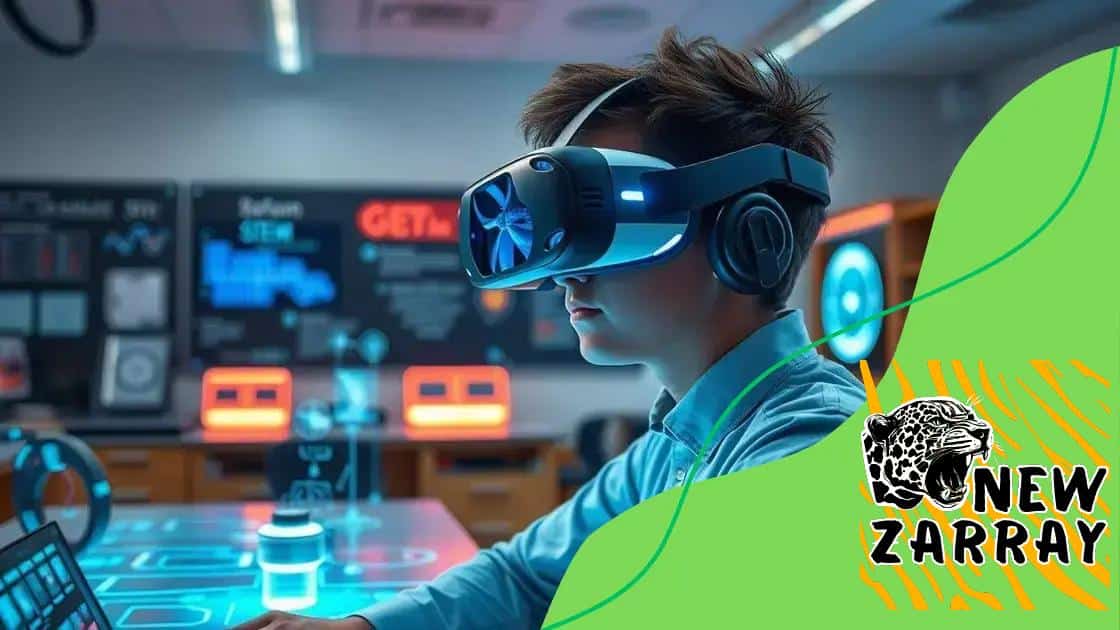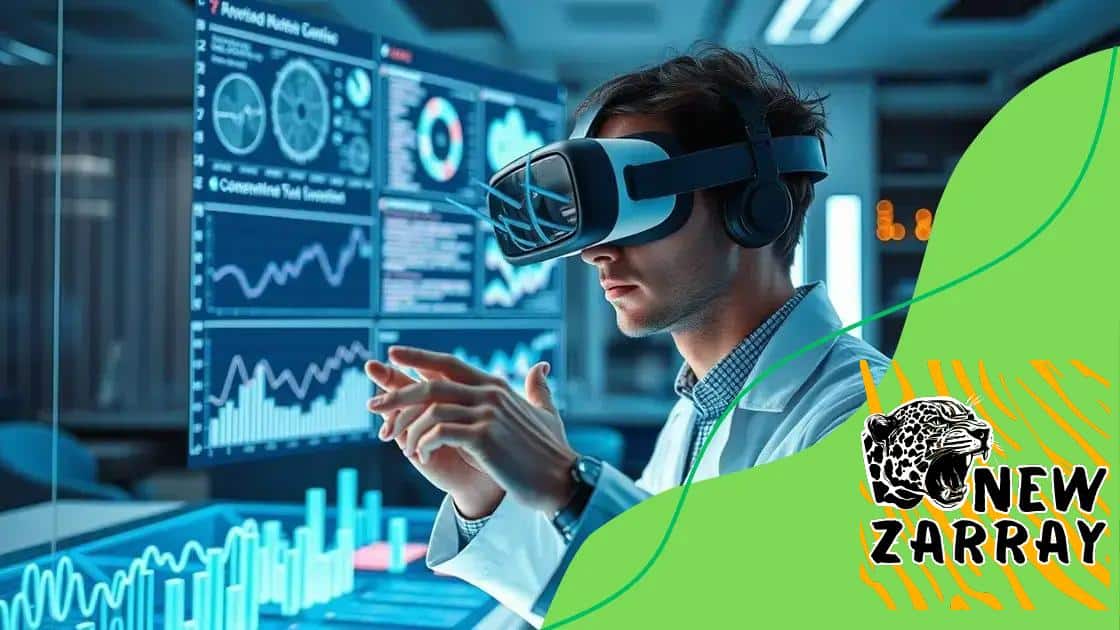Virtual reality in STEM training and research: a game changer

Virtual reality in STEM training and research enhances student engagement, provides immersive learning experiences, and fosters collaboration, making complex concepts easier to understand and apply in real-world scenarios.
Virtual reality in STEM training and research is transforming how students and professionals engage with complex concepts. Imagine exploring the depths of the ocean or the outer space—all without leaving your classroom or lab. This article delves into the excitement and potential of using virtual reality as a learning tool in STEM.
Understanding virtual reality technology
Understanding virtual reality technology is essential for grasping its role in STEM training and research. Virtual reality (VR) offers immersive experiences that revolutionize learning and innovation. It leverages computer-generated environments to simulate real-world scenarios, enabling users to interact and explore with remarkable realism.
The basics of virtual reality
VR technology relies on hardware and software to create engaging experiences. Headsets, hand controllers, and motion sensors are typical components. This technology allows users to enter a computer-generated world, where they can manipulate objects and environments.
Key components of VR
- Headsets: Devices worn on the head to deliver visual experiences.
- Controllers: Handheld devices that enable interaction within the VR environment.
- Motion tracking: Technology that detects the user’s movements within the simulated space.
- Software: Programs that create and manage the VR experiences.
As these components evolve, the potential for their application in STEM grows significantly. Researchers are exploring ways to utilize VR to enhance education, especially in complex subjects like biology, physics, and engineering.
Applications in STEM
Imagine students learning biology by virtually dissecting a frog or exploring human anatomy in detail. With virtual reality technology, these experiences become possible and engaging. It promotes active participation, making learning more memorable.
Moreover, VR can bridge geographical gaps in research collaboration. Scientists from different parts of the world can meet in a virtual space to visualize data and conduct experiments together, enhancing teamwork and innovation.
This technology not only enhances understanding but also makes challenging concepts more accessible to learners. As VR becomes more integrated into the educational landscape, it is likely to drive significant advancements in how we teach and learn in STEM disciplines.
Benefits of VR in STEM education
Benefits of VR in STEM education are becoming increasingly evident as more institutions adopt this technology. By utilizing virtual reality, educators can provide students with immersive experiences that enhance understanding and retention. This approach makes learning more engaging and interactive, especially in science, technology, engineering, and mathematics.
Enhanced engagement and motivation
One of the significant benefits of VR is its ability to capture students’ interest. Traditional teaching methods can sometimes fail to excite learners, but virtual reality introduces a dynamic element to education. Students are more likely to participate actively and remain focused on the lessons being taught.
Immersive learning experiences
- Real-world simulations: Students can engage with complex environments, such as exploring outer space or conducting chemistry experiments.
- Hands-on practice: VR allows students to practice skills in safe settings, like performing surgery or building prototypes without real-world risks.
- Cultural experiences: They can take virtual field trips to historical sites or scientific research centers, broadening their horizons.
Furthermore, VR can adapt to different learning styles. Visual learners may benefit from 3D representations, while kinesthetic learners engage better by manipulating objects. This flexibility contributes to personalized education, making it easier for students to grasp complex concepts.
Improved collaboration and communication
Another advantage of utilizing virtual reality in education is the potential for enhanced collaboration. Students can work together within a shared virtual space, regardless of their physical location. This fosters teamwork and improves communication skills among peers. When students collaborate in virtual environments, they often develop problem-solving abilities and learn to value diverse perspectives.
As educators explore the potential of VR in their classrooms, they will likely uncover even more benefits. This technology opens doors to innovative teaching methods that can inspire the next generation of scientists, engineers, and mathematicians.
Case studies of VR in research

Case studies of VR in research illustrate the transformative power of virtual reality in various fields. Researchers are increasingly adopting VR to enhance their studies and gather data in innovative ways. These real-world applications demonstrate how VR can provide unique insights and improve research outcomes.
Health and medical research
In health research, VR is making waves by allowing medical professionals to simulate surgeries and medical procedures. For instance, surgeons use VR training programs to practice complex operations in a safe environment. This not only sharpens their skills but also reduces the risk during real procedures. Studies show that medical students who train with VR perform better in real-life situations.
Environmental studies
- Simulating ecosystems: Researchers create virtual environments to observe how changes affect species and ecosystems.
- Disaster response training: VR allows teams to practice responses to natural disasters, improving preparedness without real-world risks.
- Climate change education: Immersive experiences help people understand the impact of climate change on various ecosystems.
By using VR, scientists can visualize complex data sets, making it easier to comprehend intricate relationships. Additionally, it fosters collaboration among researchers from different disciplines. For example, environmental scientists can work alongside urban planners in a virtual setting to develop solutions for sustainable city designs.
Engineering and design
Another notable application is in engineering and design. Companies employ VR to prototype and test products before creating physical models. Using VR simulations, engineers can identify potential issues early in the design process. This practice saves time and resources, leading to more efficient project development.
Similarly, architects use VR to present their designs to clients. Instead of static blueprints, a virtual walkthrough provides a realistic sense of scale and space. This approach enhances communication and ensures that clients’ needs are thoroughly understood before construction begins.
As more case studies emerge, the benefits of virtual reality in research become clearer. Researchers are discovering new ways to analyze, visualize, and collaborate on projects, positioning VR as a valuable tool for the future.
Challenges and solutions for VR adoption
Challenges and solutions for VR adoption in education and research are essential to understand as more institutions explore this technology. While virtual reality holds great promise, its implementation is not without difficulties. Educators and researchers must address these challenges to make the most of VR’s potential.
High costs and funding
One major challenge is the cost associated with VR technology. Virtual reality headsets, software, and hardware can be expensive, making it difficult for some institutions to invest in these tools. To overcome this barrier, schools and universities can seek grants or partnerships with tech companies willing to support educational initiatives through funding or donations.
Technical issues and training
- Technical support: Many educators may not have the technical background needed to troubleshoot VR systems. Providing adequate technical support is crucial to smooth operations.
- Training programs: Institutions need to implement training programs for teachers, ensuring they feel comfortable and confident using VR in their classrooms.
- User-friendly software: Developers should focus on creating intuitive software that minimizes the learning curve for both educators and students.
Another key challenge is ensuring that virtual reality content is accessible and engaging for all students. It is important to create inclusive experiences that cater to diverse learning styles. This may involve collaborating with educators and instructional designers to develop VR content that meets various educational needs.
Health and safety concerns
There are also health and safety concerns related to VR usage, such as eye strain or motion sickness. To address these issues, schools should establish guidelines for VR use, limiting the amount of time students spend in virtual environments. Regular breaks and monitoring user comfort levels are crucial for maintaining a safe experience.
In addition, educators can provide proper instruction on how to use VR safely. Teaching students about the potential risks and how to mitigate them will create a more positive learning environment.
As more institutions navigate the challenges and solutions for adopting virtual reality, the potential for innovative teaching and research will continue to grow. Addressing these barriers head-on will lead to a more effective integration of VR in educational settings.
The future of VR in STEM fields
The future of VR in STEM fields looks promising as technology continues to evolve. As virtual reality becomes more accessible and integrated into educational systems, its potential applications in science, technology, engineering, and mathematics are expanding rapidly. Educators are beginning to envision classrooms where students can experience lessons in immersive environments.
Growing adoption in education
More schools and universities are implementing VR technology to enhance STEM education. This trend indicates a shift in how students learn complex concepts. For instance, subjects like physics or biology can be taught through interactive simulations, offering students hands-on experiences without real-world consequences. These engaging methods can significantly improve understanding and retention.
Innovative research opportunities
- Data visualization: Researchers can use VR to present complex datasets in 3D, making it easier to identify patterns and relationships.
- Collaborative projects: Virtual environments allow teams from different locations to work together on scientific experiments or engineering designs.
- Enhanced training: Professionals in various STEM fields can use VR for training, perfecting their skills without the risks associated with real-life practice.
As VR technology improves, it is likely to incorporate artificial intelligence, creating even more personalized and adaptive learning experiences. AI can tailor VR simulations to meet the specific needs of individual students, ensuring they grasp concepts at their own pace.
Challenges to overcome
While the future is bright, there are also challenges that need addressing. One major issue is achieving seamless integration into existing curricula. Training educators to effectively use VR technology is essential for its success. Additionally, ensuring that all students have access to the necessary equipment is critical.
As technological advancements continue, it is expected that VR will play a pivotal role in shaping the next generation of STEM professionals. By enhancing learning experiences and providing innovative solutions for complex problems, virtual reality stands to transform how we teach and learn in these fields.
FAQ – Frequently Asked Questions about Virtual Reality in STEM Education
How does virtual reality improve student engagement?
Virtual reality creates interactive and immersive experiences that captivate students’ attention, making learning more enjoyable and effective.
What are the potential challenges of implementing VR in schools?
Challenges include high costs, the need for technical training for educators, and ensuring that all students have access to VR technology.
How can VR be used in STEM fields?
VR can simulate real-world scenarios, allowing students to practice skills in a safe environment, visualize complex data, and collaborate on projects from different locations.
What is the future of VR in education?
The future of VR in education looks bright, with advancements making it more accessible and effective, allowing for personalized learning experiences and innovative teaching methods.





